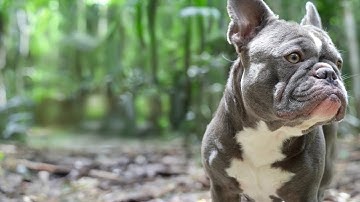
French Bulldog
Canis lupus familiaris

Meet the French Bulldog
The French Bulldog is a small, muscular domestic dog breed known for its distinctive bat-like ears, short snout, and compact build. Originating in the 19th century as a companion animal in France, this breed is popular worldwide for its affectionate and sociable nature. French Bulldogs are well-adapted to urban environments, making them ideal pets for apartment dwellers. Their playful yet easygoing temperament, combined with minimal grooming needs, has contributed to their popularity as family pets. However, due to their brachycephalic facial structure, they can be prone to certain health issues, especially respiratory problems.
Classification
Mammal
Habitat
Domestic (Urban, Suburban Homes)
Diet
Omnivore
Lifespan
10-12 years
Conservation
Least Concern
Weight
16-28 lbs (7-13 kg)
📖Fascinating Facts
Distinctive Ears
French Bulldogs have large, upright 'bat ears' that are a signature feature of the breed and contribute to their expressive appearance.
Adaptable Companions
They are highly adaptable to various living situations, thriving in apartments and urban environments due to their small size and low exercise needs.
Sleepy Personalities
French Bulldogs are known for their love of sleep and can spend much of the day napping, making them relatively low-energy pets.
📋Detailed Description
The French Bulldog (Canis lupus familiaris) is a compact, muscular breed typically weighing between 8–14 kg (18–31 lbs) and standing 28–33 cm (11–13 in) at the shoulder. Its most distinctive features include large, upright 'bat ears,' a short, broad muzzle, and a pronounced brachycephalic (flat-faced) skull, which contribute to its unique expression. The coat is short, smooth, and comes in a variety of colors including brindle, fawn, white, and pied. Anatomically, French Bulldogs have a wide chest, well-developed muscles, and a short, screw-shaped tail. Behaviorally, they are known for their affectionate, playful, and sociable temperament, forming strong bonds with their human families and often displaying a gentle disposition towards children and other pets. French Bulldogs are generally quiet, rarely barking excessively, and are well-suited to apartment living due to their moderate exercise needs. Social by nature, they thrive on human interaction and can experience separation anxiety if left alone for extended periods. Reproductively, the breed often requires veterinary assistance for mating and birthing due to anatomical constraints, particularly the large head size relative to the pelvis. Unique adaptations include their ability to communicate through a wide range of vocalizations and facial expressions, compensating for their limited endurance and heat tolerance. Despite their popularity, French Bulldogs are prone to several health issues, especially those related to their brachycephalic structure, such as respiratory distress, skin fold dermatitis, and spinal disorders.
💡 Did you know?
Despite their name, French Bulldogs actually originated from English Bulldogs and were further developed in France by lace workers who brought them from England.
🔬Research & Sources
Wikipedia Summary
The French Bulldog is a French breed of companion dog or toy dog. It appeared in Paris in the mid-nineteenth century, apparently the result of cross-breeding of Toy Bulldogs imported from England and local Parisian ratters. It is commonly kept as a pet and is among the most frequently registered dogs in a number of countries including Australia, the United Kingdom, and the United States. The breed is susceptible to various health problems as a consequence of being bred for a distinctive appearance, sporting a brachycephalic face and skin wrinkles.
Last Modified: 6/6/2025
🎭Behavior & Social Structure
French Bulldogs are highly companion-oriented, preferring close proximity to their owners and often following them from room to room. They exhibit a playful yet non-aggressive demeanor, engaging in short bursts of activity interspersed with long periods of rest. Unlike many breeds, French Bulldogs have a low prey drive and rarely display hunting behaviors, though some retain a mild interest in chasing small moving objects. Feeding behavior is opportunistic; they are prone to overeating if not portion-controlled, which can lead to obesity. Social interactions are generally amicable, with most individuals tolerating other dogs and household pets, though early socialization is recommended to prevent territorial tendencies. Daily routines typically involve moderate exercise, such as short walks and indoor play, as the breed is sensitive to heat and overexertion due to compromised respiratory function. French Bulldogs are known for their expressive body language, using a combination of vocalizations (snorts, grunts, yips) and facial cues to communicate needs and emotions.
👶Reproduction & Life Cycle
French Bulldogs exhibit unique reproductive challenges due to their conformation. Natural mating is often difficult, and artificial insemination is commonly employed. The average gestation period is approximately 63 days. Due to the breed's large head and narrow pelvis, over 80% of French Bulldog litters are delivered via cesarean section to prevent dystocia (obstructed labor). Litter sizes are typically small, averaging 3–5 puppies. Parental care is primarily provided by the dam, though human intervention is frequently necessary to assist with feeding and care, especially in the first weeks of life. Breeding seasons are not strictly defined, as domestic dogs can cycle year-round, but responsible breeders often limit frequency to maintain maternal health. Neonatal mortality can be higher than average due to congenital defects associated with brachycephaly.
🛡️Adaptations & Survival
The French Bulldog's compact, muscular build and low center of gravity make it well-adapted for indoor living and companionship rather than athletic or working roles. The breed's brachycephalic skull, while aesthetically distinctive, is an evolutionary trade-off that limits heat tolerance and respiratory efficiency. Their large, upright ears enhance auditory sensitivity, compensating for their limited olfactory prowess compared to other breeds. Behaviorally, French Bulldogs have evolved strong social bonds with humans, displaying attachment behaviors and a high degree of trainability for basic commands and routines. Their minimal grooming requirements and low-shedding coat are advantageous for urban environments. However, their short snout and airway structure necessitate careful management in hot or humid conditions, as they are prone to heatstroke.
📚Research Sources
🎨Cultural Significance
French Bulldogs have become cultural icons, symbolizing urban sophistication and companionship. Their distinctive appearance and charming personalities have made them popular in advertising, social media, and celebrity culture. The breed is often associated with the Parisian lifestyle, reflecting its origins in 19th-century France. French Bulldogs have appeared in art, literature, and film, frequently depicted as loyal and endearing companions. They are also popular mascots and have been featured in fashion campaigns and as pets of high-profile individuals. In some societies, the breed's status as a luxury pet has led to increased demand and, consequently, higher market value.
🔬Recent Research & Discoveries
Recent scientific research has focused on the genetic basis of brachycephaly and associated health problems in French Bulldogs. Genome-wide association studies have identified mutations in genes such as SMOC2 and BMP3 that contribute to craniofacial morphology. Veterinary studies have highlighted the high prevalence of BOAS and its impact on quality of life, prompting calls for revised breeding standards. Ongoing research is investigating surgical and non-surgical interventions to alleviate airway obstruction. Studies on canine behavior have confirmed the breed's strong attachment to humans and susceptibility to separation anxiety. Population genetics research is also being conducted to assess genetic diversity within the breed and inform responsible breeding practices.
🎥Wildlife Videos

French Bulldogs | Dogs 101
This dog has the pushed in face and adorable snorting...it can only be the French Bulldog! But, did you know that they actually ...
Animal Planet

Nature Documentary on the French Bulldog
In a David Attenborough style nature documentary, I took my friend's dog, Franklin, to a trail near my house and made a mini ...
Austin March

Wildlife - The Fascinating World of Wild Animals | Full Series | Free Documentary Nature
Wildlife - The Fascinating World of Wild Animals | Wildlife Documentary Watch 'Ocean Stories - Full Series' here: ...
Free Documentary - Nature

Wild France - A Spectacular Journey | Part 2 | Free Documentary Nature
Wild France - A Spectacular Journey: Part 2 | Wildlife Documentary Watch 'Wild France - Part 1' here: ...
Free Documentary - Nature

Wild France - A Spectacular Journey | Part 1 | Free Documentary Nature
Wild France - A Spectacular Journey: Part 1 | Wildlife Documentary Watch 'Wild France - Part 2' here: ...
Free Documentary - Nature

Short Documentary. The Good Boy - The life of a French Bulldog. Narrated by David Attenborough(ish)
frenchbulldog #davidattenborough #pets #doglife #frenchie #documentary #pets.
Alexander the Grant
🌍Habitat Information
The French Bulldog typically inhabits Domestic (Urban, Suburban Homes) environments. French Bulldogs have adapted to their environments with specialized features and behaviors.
Primary Habitat:
Domestic (Urban, Suburban Homes)
More detailed habitat information will be available soon.
🛡️Conservation Status
The French Bulldog is currently classified as Least Concern. Conservation efforts are crucial for preserving this species for future generations.
Common Threats:
- 🏠Habitat loss and fragmentation
- 🌡️Climate change impacts
- 🎯Hunting and poaching
- 🏭Human-wildlife conflict
⚠️Threats & Conservation Challenges
French Bulldogs face significant health challenges primarily due to selective breeding for exaggerated physical traits. Brachycephalic obstructive airway syndrome (BOAS) is prevalent, leading to breathing difficulties, exercise intolerance, and increased risk of heatstroke. Other common issues include intervertebral disc disease, hip dysplasia, patellar luxation, and skin fold dermatitis. The breed's popularity has led to irresponsible breeding practices, increasing the incidence of genetic disorders. Overbreeding and high demand have also contributed to puppy mills and illegal trafficking. While not at risk of extinction, these health and welfare concerns represent ongoing challenges for the breed's long-term viability and quality of life. Regulatory efforts in some countries aim to improve breeding standards and reduce the prevalence of inherited disorders.
🔬Scientific Classification
Scientific Name
Canis lupus familiaris
Classification Hierarchy
🔍 About Taxonomic Classification
Taxonomic classification is a hierarchical system used by scientists to classify and organize living organisms based on shared characteristics and evolutionary relationships.
The system moves from broad categories (Kingdom) to increasingly specific ones, with each animal's scientific name typically consisting of its Genus and species.
📝Community Notes
Share your observations and insights about the French Bulldog with our community of wildlife enthusiasts.
Join Our Community
Sign in to share your observations and connect with fellow wildlife enthusiasts.
Sign In to ContributeNo community notes yet
Be the first to share your observations about the French Bulldog!
Explore French Bulldog
Select a tab above to learn more about this amazing animal.
📸Photo Gallery
No photos available for this animal yet.
🌟Discover More Wildlife
Continue your journey of discovery with more fascinating animals from our database
